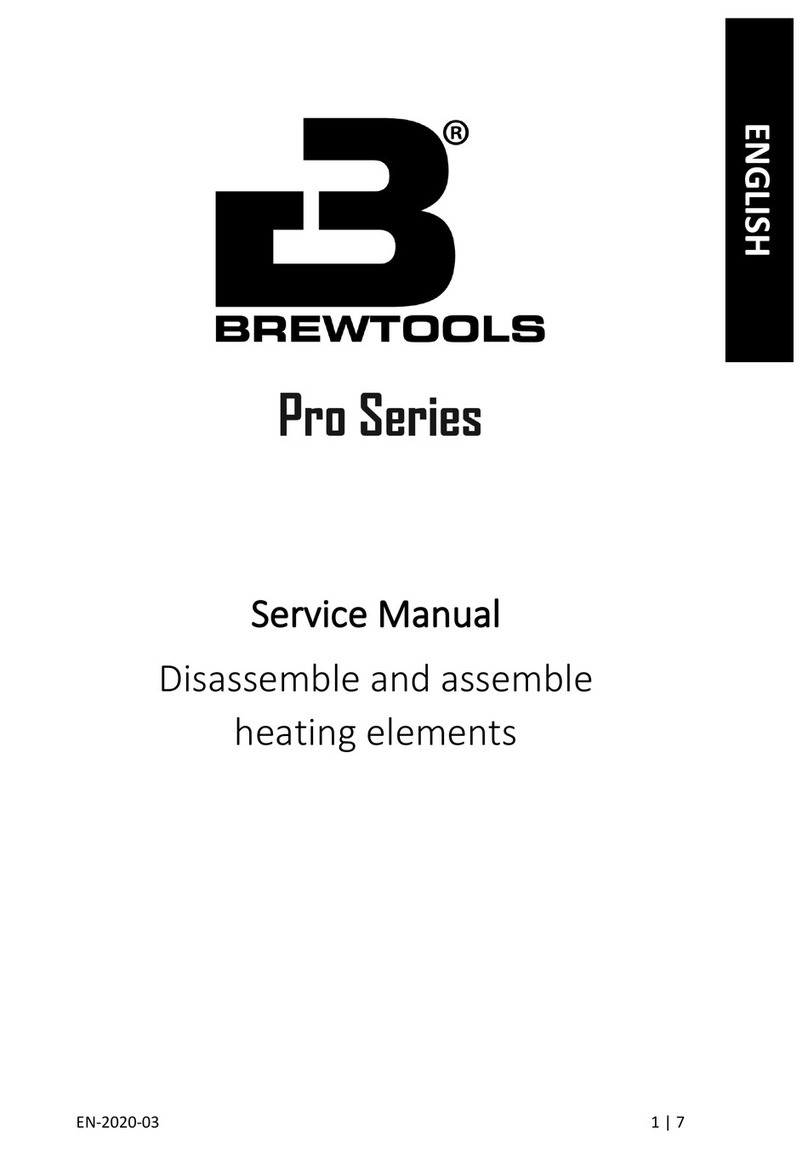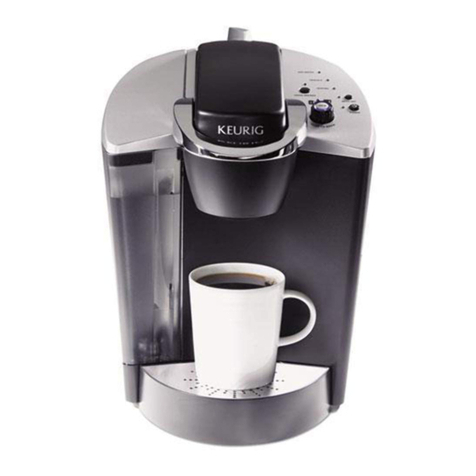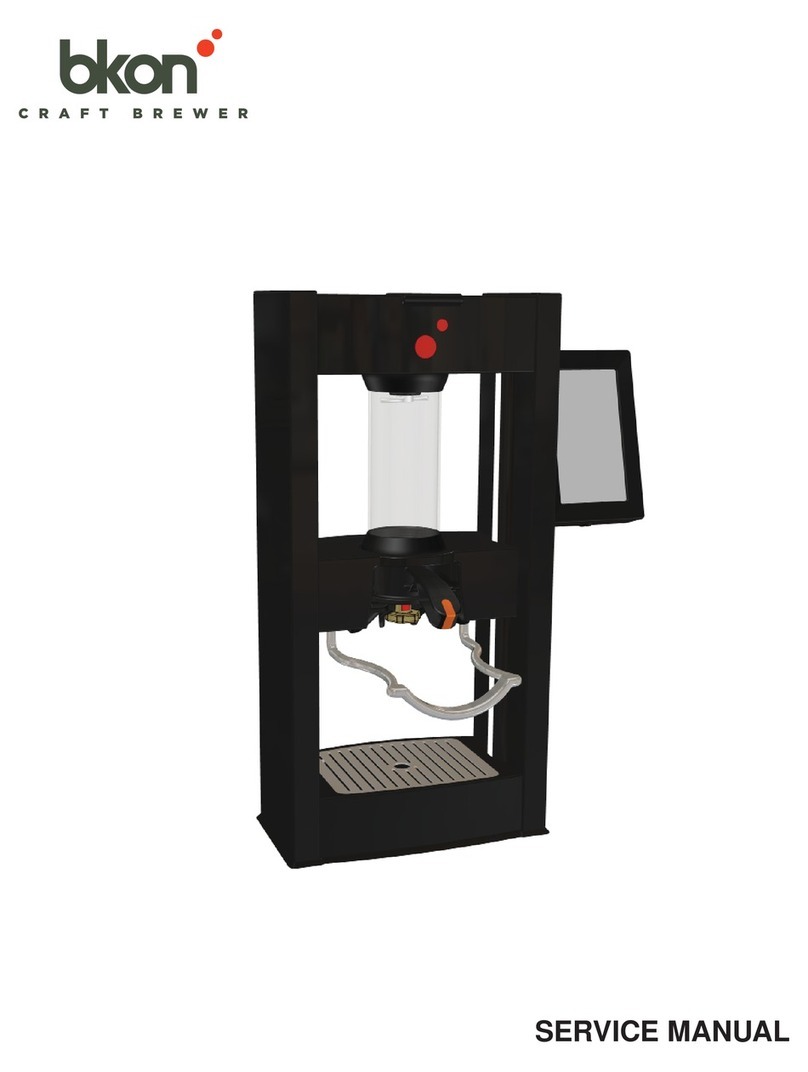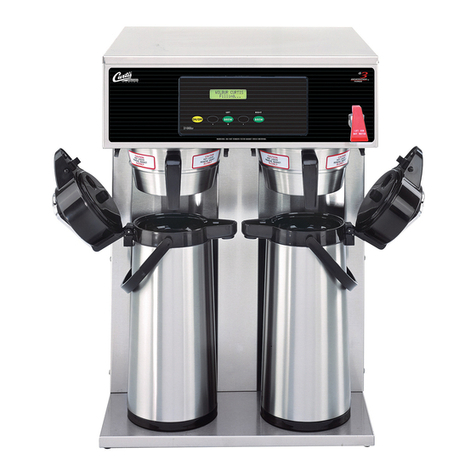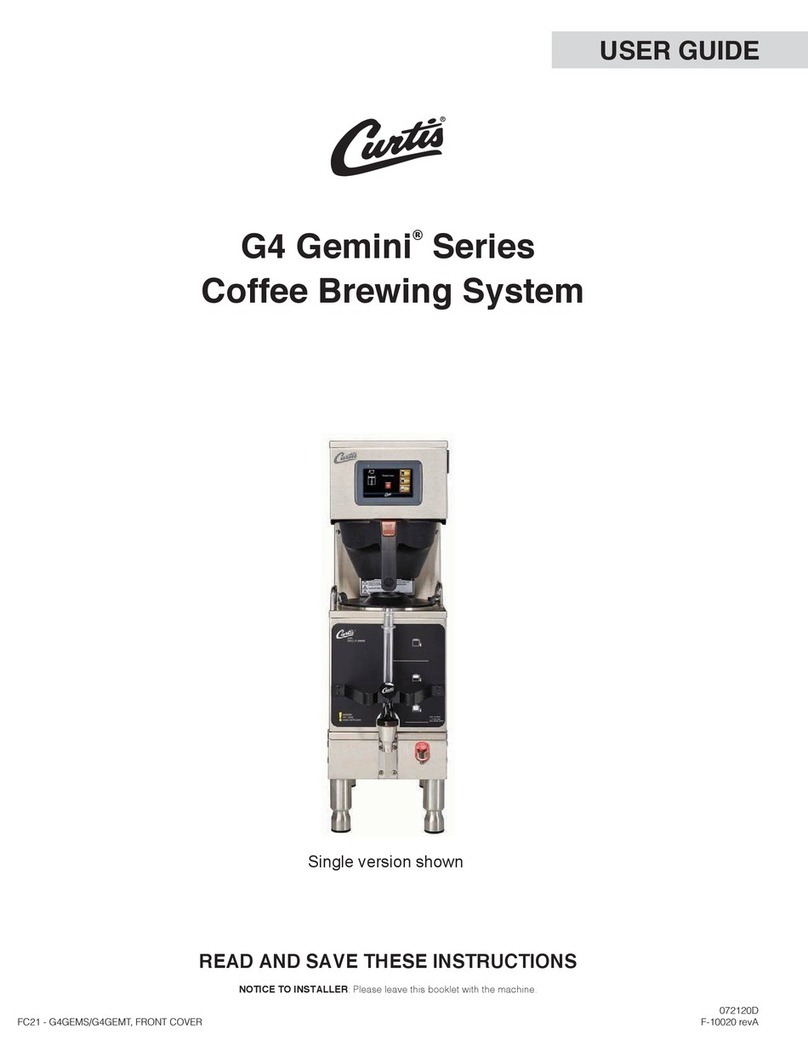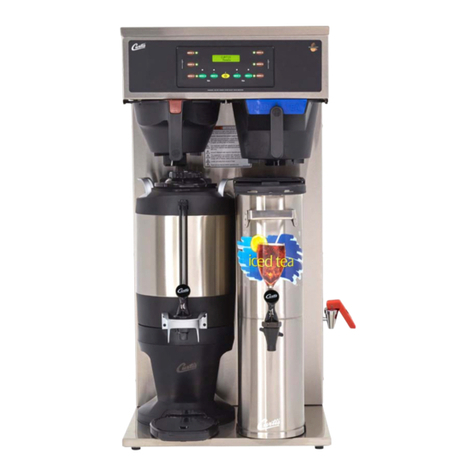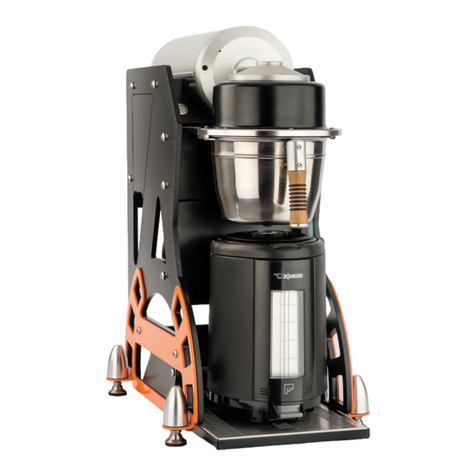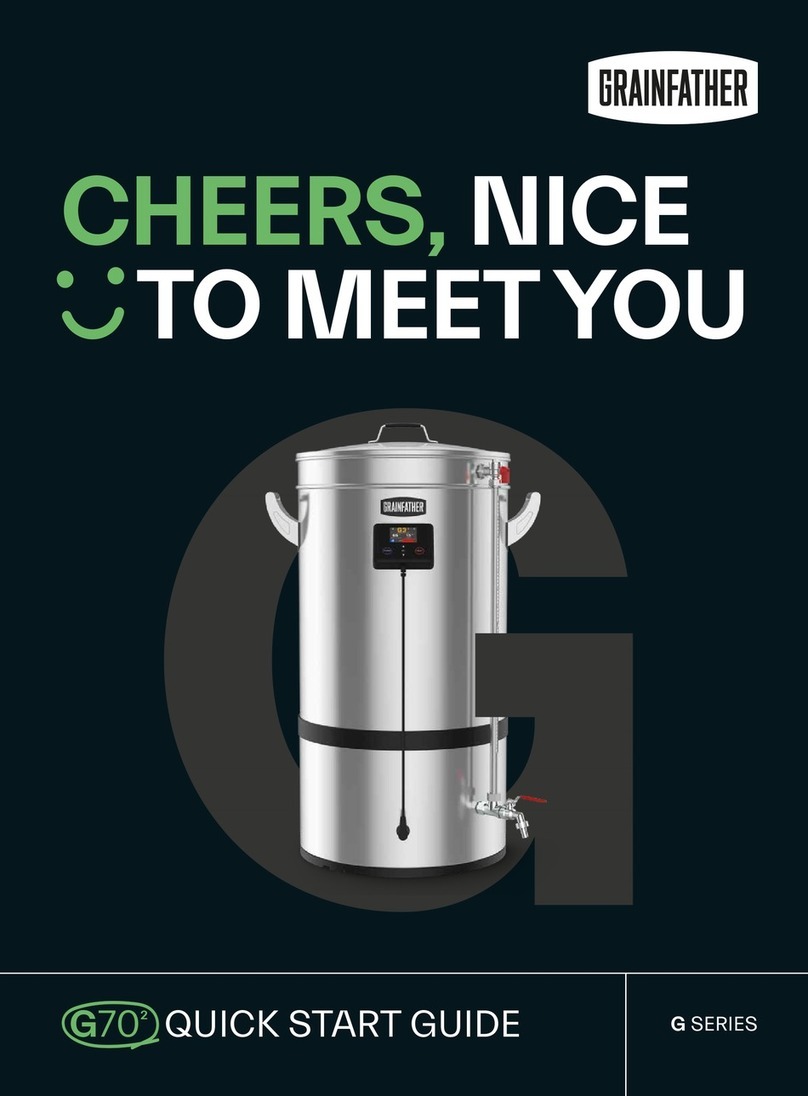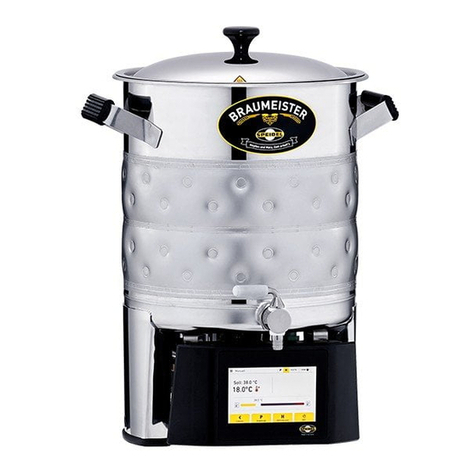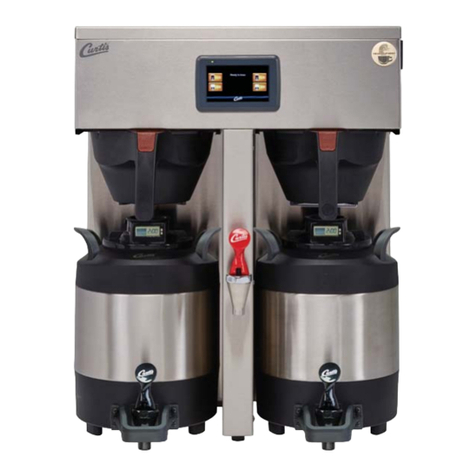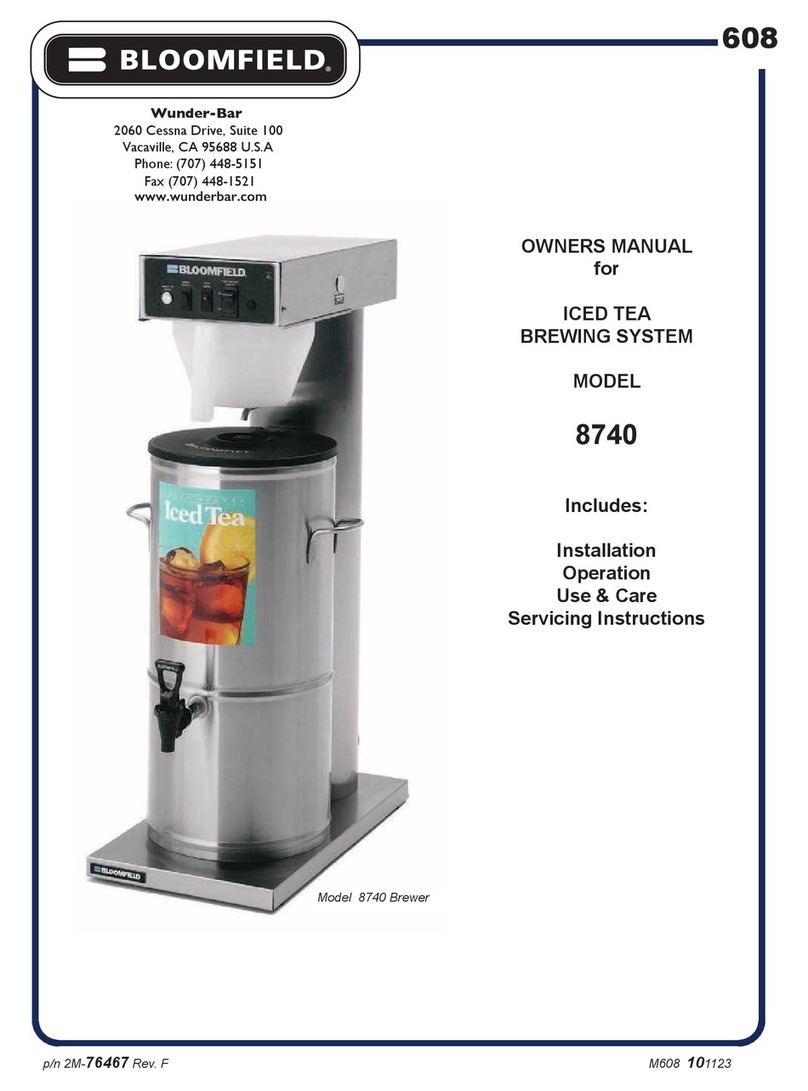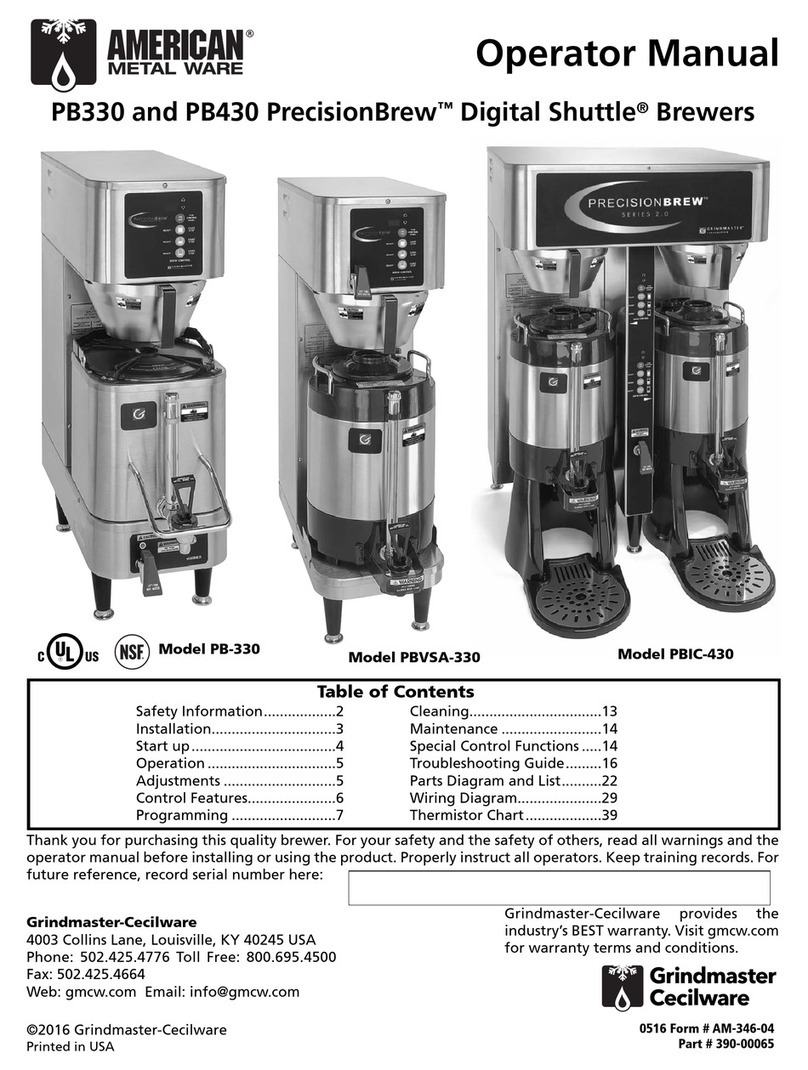Brewtools Pro Series User manual

7712206-User Manual-EN-2019-9 1 | 22
Thank you for buying this product. We hope you will be satisfied with it.
If you have any questions, please contact your local dealer or with us directly.
Contact information can be found on www.brewtools.com
User manual
ENGLISH

7712206-User Manual-EN-2019-9 2 | 22
CONTENTS
Safety Instructions
3|22
Introduction
4|22
First-time use
5|22
Using the system
9|22
FAQ
19|22
Specifications
21|22
Declaration of Conformity
22|22

7712206-User Manual-EN-2019-9 3 | 22
Safety instructions
Keep children away from packaging materials. Plastic bags can cause
choking.
Make sure the power cable(s) are undamaged. Do not use the product if
the power cable(s) are damaged due to risk of fire and electric shock.
The product must be positioned on a flat and stable surface before use.
Connectors and clamps should be checked and tightened if necessary,
before each use to avoid leaks.
The surface of the product gets very hot. Do not touch hot steel parts
during use due to risk of scalding and burns.
Learn the function of the valves before you fill the tank with water. Use
blind caps on unused output ports due to risk of spillage of boiling/hot
liquid that may cause scalding and burns.
Do not fill the tank passed the maximum mark. During boiling, reduce
the power to avoid boil over. Risk of scalding and burns.
The product has a powerful pump. Before using the pump, make sure
valves are set to the correct position. The pump speed can be adjusted
on the touch screen. Too much flow through the pump, for example
during circulation over the grains can cause liquid to spray outside the
tank. Risk of scalding and burns.
The heating elements are designed to heat liquids and must not be
turned on without being completely submerged. Boiling liquids will
evaporate and reduce the volume in the tank over time. During
circulation the liquid around the malt pipe will be reduced. Make sure
there is always enough flow to keep the heating elements covered. The
product must not be used without supervision
Make sure the power cables are inserted correctly. There are grooves in
the connectors that needs to match the sockets.
During cleaning, the power supply must be disconnected. The machine
must not be sprayed down on the outside. The electrical control system
is protected from water splashes, but not spraying water.
The product is mostly constructed of highly conductive materials. Only
use the product on circuits with a residual circuit breaker due to risk of
electric shock in the event of an electric component failure.
The power cable(s) must be disconnected when the product is not in
use.
If you find a fault with the product that may pose a risk, stop using the
product and contact the manufacturer or the reseller.

7712206-User Manual-EN-2019-9 4 | 22
Introduction
The Pro-series Brewing Systems are built without compromise and is the product series that
will always offer the highest level of flexibility, accessories and support for high-end
solutions. The Pro-series consist of 3 models of different brew volumes, but they are all
based on the same design principle and uses the same control system. The model name tells
you the maximum recommended boil volume.
B40pro B80pro B150pro
The key concept of these brewing systems is to use Tri-Clamp connections for tool-free and
sanitary use. These offer great flexibility and offers the user the choice of different setups
based on your preference.
TC 34mm silicone gasket, clamp and 19mm hose barb
This user manual will teach you how to prepare the system for the first time, how to use it,
clean it and maintain it. You’ll also find an FAQ which addresses some questions that might
arise during use.
We recommend checking out or website, www.brewtools.com, to find the latest
information and other tips and advice.

7712206-User Manual-EN-2019-9 5 | 22
First-time use
This chapter will tell you how to do the necessary steps to
prepare your system for use.
For a full video walkthrough of the assembly and preparation
of the system, check out www.brewtools.com or scan the QR
code.
Assembly
Unpack all the parts and place the brewing system upside down. Connect the power cables
and other accessories like the return temperature sensor if you have that. The power cables
should exit one of the service holes on the back of the system. The connectors have grooves
that only allows the connector to be installed correctly. Do not use excessive force when
plugging in the connectors. The optional return temperature sensor should go through the
left silicone grommet that is already installed.
Flip the system the right way up and install the 3-way valve on the right side as shown
below. Install the pump temperature sensor in the sensor adapter included with a gasket
between the sensor and the adapter. Install the assembled sensor adapter on the rear
outlet using a TC clamp with a gasket. Cut a part of the included silicone tube and install it
between the sensor adapter and the pump. Make sure the tube has a nice curve to avoid
blockages.
3-way valve on the right side with sensor adapter and pump inlet tube.

7712206-User Manual-EN-2019-9 6 | 22
Install two o-rings on the top two grooves on the center pipe. Use the size marked 16x2mm.
If you want a tighter fit, use the 18x2mm o-rings. Install 18x2mm o-rings on the dip-tube(s).
Finally, install 22x2mm o-rings on the outside grooves of the mash hat. The dip should be
installed on the right outlet port inside the tank. It is recommended to moisten the o-rings
before use. The dip tube position can be adjusted to your preference. More details on this
subject is described in the “Dip tube” section of the later on.
Center pipe (16x2mm), dip tube (18x2mm) and mash hat (22x2mm)
Install 3 blind caps on the open ports indicated below to avoid spilling. If you have extra
valve(s), you can use the blind caps as preferred.
B80pro –Recommended blind cap placement

7712206-User Manual-EN-2019-9 7 | 22
Install the 3 legs of the malt pipe using an allen key. Take note that the latches must be
installed as shown below, and the wing nut must be used on the outside of the malt pipe.
Alternatively you can use the included hex nut. Install the silicone leg protectors to avoid
scratching the bottom of the main tank during use.
Combined leg and holder for malt pipe
Check for leaks
When filling the tank with water for the first time, make sure the taped threads on the
pump and the sensor and heating elements gaskets are not leaking. Tighten if necessary.
Also check that all TC clamps are tightly installed. The TC clamps might require tightening
after use, due to the variations in temperature.
The filter
The filter included is made from expanded metal and might have some tension. Make sure
the filter is flat. Flatten by hand if necessary. The filter should be cleaned before use to
remove any residue from production.
Cleaning
The system should be thoroughly cleaned before use to remove polishing compounds and
flux from the production process. Use Trisodium Phosphate (TSP) or other chemicals
designed for this type of cleaning. Use a microfiber cloth to wipe all surfaces clean.

7712206-User Manual-EN-2019-9 8 | 22
Passivation
We recommend passivating the steel before first-time use and 1-2 times a year. Use StarSan
or similar acid-based chemicals. Fill the tank with lukewarm water. Use approximately 5ml
StarSan per liter and leave it for 15-20 minutes.
Electrical connection
The system must be connected to an earthed socket with a residual circuit breaker. The
control system supports two individual circuits. This feature is used on the B40pro 110V
version, the B80pro and the B150pro due to the power requirements. The 240V versions of
the B40pro runs on one circuit. The software offers the possibility to reduce the average
maximum power to adapt to your circuit breaker limitations. You can choose between 10A,
13A, 15A and 16A for each circuit in the control system. Take note that this feature is based
on standard voltage ranges, and variations may occur. We recommend testing different
settings to find the best option for your location.
The display and the control system are always powered by the main power input. If you lose
power on the main circuit, the system will turn off. The second power supply is only used to
power the second heater on some models, and the control system will not recognize the
loss of power on the second circuit.
Simple function test
Fill the tank with water to cover the heating elements. Start the system in manual mode,
and check the following:
•Temperature is correctly read by all sensors.
•The pump is running and can be adjusted on screen.
•Both heating elements are working (bubbles will form on the elements)

7712206-User Manual-EN-2019-9 9 | 22
Using the system
This section explains how to use the system and gives you
some good advice and recommendations for use.
For more information regarding the system and different
setups, visit www.brewtools.com, or scan the QR code.
The control system
The systems are equipped with a 7” touch screen
controller.The software can be updated for free through the
built-in WiFi-module. When a new version of the software is
available, it will automatically download and prompt the user
to install it. If the user does not update right away, the new
software will automatically be installed during the next
startup.
The software is constantly being updated and new features
added, so we will not cover the software in this user manual.
Visit our website, www.brewtools.com or scan the QR-code to
get the latest information on our Pro series software.
Valves
The system two T-type 3-way ball valves as standard. One side valve, and one bottom valve.
The valves only close the port opposite to the direction the handle is pointing. If the handle
points toward the middle port (as shown below), all ports are open.
3-way valve shown with all ports open

7712206-User Manual-EN-2019-9 10 | 22
The illustrations show the fluid flow (green) in the 3-way valves based on the handle position.
The bottom valve has an extended handle which makes it possible to control from the right
side of the control system. There is a sticker showing the flow based on the handle
direction.
Bottom valve sticker

7712206-User Manual-EN-2019-9 11 | 22
Dip tube
The dip tube position is adjustable and is normally used in the two positions shown below.
We recommend positioning the dip tube in the upper position during mashing (especially
when getting to know the system) to prevent the heaters becoming exposed. Exposing the
heating elements will burn them and make them difficult to clean. They might also
warp/expand due to the high heat. You can use the mash paddle or equivalent to push the
dip tube down when the mashing is complete to get as much wort as possible pumped to
the fermenter later in the process.
Dip tube in the upper position
Dip tube in the lower position

7712206-User Manual-EN-2019-9 12 | 22
The pump
The pump must never run without fluid in the chamber. This will cause damage to the
magnetic impeller. In the beginning of the brew, air may be trapped inside the pump. To
vent it, start the pump for a few seconds, stop it, and start it again. Repeat if necessary.
The pump must be installed as shown below. If you install it in a different position, it may
affect the lifetime of the pump and make it difficult to vent the air out.
Correct position of the pump
Correct position of the pump

7712206-User Manual-EN-2019-9 13 | 22
Preheating
We recommend heating the strike water before you install the center pipe and malt pipe for
an even temperature. We also recommend circulating the water. The bottom valve handle
must point to the “UP CENTER” position
Crushing the grains
We recommend using grains that’s not too finely crushed to get the maximum flow through
the grain bed. If you use a lot of special grains like wheat or oats, or you push the limits of
the malt capacity, we recommend using rice hulls to increase the flow. The systems ship as
standard with the coarse malt pipe filter and our recommended crush grade is 1.2-1.3mm.
Adjusting the malt pipe holders
The latches on the malt pipe may need some adjustment. They should move freely. Push
them together to remove it from the latch holder. Adjust as necessary and reinstall the
latch. The lower “pin” on the latch can be bent to position using a suitable tool
Lifting the malt pipe
The handle on the malt pipe is designed to be easily removed for cleaning and use of future
accessories. Make sure to always lift the malt pipe from the center of the handle to avoid it
coming loose. On the larger systems, the malt pipe can be very heavy. We recommend using
a lifting system if available.
When lifting the malt pipe, make sure to only lift it high enough for the 3 latches to fall out
and grab the edge. If you lift the bottom of the malt pipe higher than the center pipe, you
may have difficulties getting the malt pipe seated back on the center pipe.

7712206-User Manual-EN-2019-9 14 | 22
Different setups
The system can be set up in many ways. Below, we show 3 recommended options based on
your accessories.
Standard setup
Two-valve setup

7712206-User Manual-EN-2019-9 15 | 22
Three-valve setup
Circulating during mashing
We always recommend resting the mash for 20 minutes after stirring in. In this period, we
recommend circulating on the outside of the malt pipe. This is done by pumping the wort
out through the lower port (red) and into the tank again on the left port (green). Use a dip
tube to make sure the wort is circulating around the malt pipe. This will give you a more
accurate temperature and prevent the heating elements burning the sugars. You can
circulate through the counterflow cooler, if you have that.
B40pro –Circulating during the mash

7712206-User Manual-EN-2019-9 16 | 22
By setting the bottom valve in a middle position shown below, you can circulate both
outside the malt pipe and over the grain bed. With this solution you can set the pump
power high (70-100%). Make sure the liquid level outside the malt pipe is stable and the
heating elements never expose. As recommended earlier, the right dip tube can be set in
the upper position to prevent this. Use the bottom valve to adjust the flow over the grains
based on your flow rate through the grain bed.
Sticker for bottom valve showing the area you should operate on during combined circulation
Sparging
The system ship as standard with a sparge pipe. This pipe will sit outside the center pipe
during the mashing process. When lifting the malt pipe, the sparge pipe will lift with it thus
extending the center pipe. If you are sparging from a second water heater, we recommend
connecting the sparge water on the front-facing port on the right 3-way valve. This allows
you to pump the sparge water up the center pipe from the water heater, using the internal
pump. Adjust the pump speed as needed. Make sure to not sparge with more water than
the main tank can hold.
When lifting the malt pipe during sparging, the liquid level will drop and expose the heating
elements. It is important that you turn off the heating elements before lifting the malt pipe.

7712206-User Manual-EN-2019-9 17 | 22
Boiling
Boiling can be done without a lid (open boil) or using a steam hat (accessory), if you have a
ventilation system. You can also use the steam hat with our steam condenser (accessory) if
you don’t have a ventilation system. During the boiling process it is important to adjust the
power to get a satisfactory boil. Take note that adding hops might cause the wort to boil
over.
It is not recommended to use the pump during the pump during the whole brewing process,
as hop pellets might clog the dip tube and pump. We recommend adding hop pellets on the
opposite side of the pump intake. Whole hops should not be used directly in the tank as
they will clog the pump intake. To disinfect the counterflow cooler and tubes, circulate
through the cooler at least 10 minutes before starting the cooling process. Take note that
you might need more power to keep the boil going when running the pump
Cooling and transferring
You can use your preferred method for cooling the wort. An immersion chiller will work but
will limit the whirlpool functionality.
We recommend using our custom counterflow cooler (accessory). It is designed for
maximum flow to get a good whirlpool while cooling the wort. We recommend circulating
through the counterflow cooler and back into the tank on the left side with a dip tube on
the inside to create a whirlpool. When the desired return temperature is reached (can be
measured with optional return temperature sensor), the wort is pumped directly to your
fermenter by adjusting the left port 3-way valve (accessory, based on setup).
Cleaning
Regular cleaning is critical to keep the quality of your beer, and also to make your brewing
system last you a long time. We recommend using a cleaning agent that does not harm
Teflon (PTFE). Our 3-way valves uses PTFE bushings. PBW is not recommended to use for
more than 30 minutes at a time.
During cleaning, we recommend using the pump to circulate through the counterflow cooler
and all tubes. To empty the tank, remove the center pipe. The bottom valve handle is turned
to drain the through the lower port. Use a bucket or a tube going directly to a floor drain.
If you have access to pressurized air, this is a great option to blow water out of the pump
and pipes. Take note that the silicone tubes are not designed for high pressure.

7712206-User Manual-EN-2019-9 18 | 22
Maintenance
Normal cleaning, rinsing and drying the tank, tubes, and cooler is sufficient. Tubes should be
replaced when severely discolored.
If valves start leaking due to wear or stuck particles, we offer a rebuild kit for them. O-rings
and gaskets are replaced as needed. The pump impeller should be checked from time to
time to make sure no particles or grains are stuck.

7712206-User Manual-EN-2019-9 19 | 22
FAQ
This section covers some of the most frequently asked questions or challenges that may occur.
Q: The pump makes a noise, but no liquid is being pumped
A: You might have air in your system. Start and stop the pump a few times to vent it. Check
that the bottom valve is correctly set. Check that the pump is installed as described earlier.
Check for blockages in dip tube or elsewhere.
Q: The pump doesn’t run
A: Check that the cable is correctly installed and that the pump speed is set to max on the
control system. If nothing happens, turn of the pumps, disconnect the cable and remove the
pump. Check that no particles is blocking the impeller or that sugars have hardened inside,
locking the impeller.
Q: The selected sensor is showing N/A
A: If the selected sensor shows N/A on the display, it means the system isn’t reading the
sensor. Check the connection and restart the system. If the problem persists, contact the
dealer or manufacturer.
Q: Why is the tank and pump sensor showing different temperatures?
A: The temperature sensor in the pump outlet can be affected by ambient temperatures
and will normally show a lower value than the tank sensor. You can correct for this in the
software (see the online manual). If you think the sensors have a problem, leave the system
in a room with a stable ambient temperature overnight, and check the sensors in an empty
system.
Q: Should I use an insulation jacket?
A: The insulation jacket will have a positive effect on your energy usage as it prevents heat
loss. We recommend using the jacket if brewing outside or in a cold room.

7712206-User Manual-EN-2019-9 20 | 22
Q: How do I avoid burning the heating elements?
A: Make sure the heating elements are always covered with liquid. If you do a manual step
mash, use the «mash mode » to limit the power output on the heating elements. Some
grain types like wheat and flaked oats might increase the risk of burning the heating
elements.
Q: The heating elements are touching the edge of the tank. Is this normal?
A: No, there is normally a 10-20mm space between the tank wall and the heating elements.
If you’ve run the heaters dry, they might have expanded, and the heating elements become
more difficult to clean. The minimum distance is 5mm. If the heaters are touching the wall,
the main tank might become discolored.
Q: I don’t have two 16-A circuit breakers. What do I do?
A: The system is designed to be able to limit the average power output to allow usage on
lower current circuits. Check out the section about limiting the power output in the user
manual.
Q: What is the maximum grain capacity?
A: The maximum grain capacity is found in the specifications and on the product page on
our website. Pushing the capacity limits will lower your mash efficiency.
Q: How do I avoid «stuck mash»?
A: Using rice hulls and the correct crush grade is key. We recommend resting the mash (not
circulating over the grain bed) the first 20 minutes of the mash process.
Q: Should I stir the grains during mashing?
A: It is important that all the grains are wet and mixed well with the mash water. If you get a
stuck mash, you should stir lightly, but stirring will generally reduce the clarity of the wort.
Q: Can I use the standard silicone tube for tap water?
A: No, the standard silicone tubes are not designed to withstand the tap water pressure.
Q: How often should I tighten the nuts on sensors and heating elements?
A: It is a good idea to check the nuts regularly. Also check the TC clamps under the main
tank regularly.
Q: How do I update the system firmware?
A: When a new firmware version is available, the system will automatically download it and
prompt you to install it. This requires a working WiFi connection and that the MicroSD card
is installed. The MicroSD card is installed when the system is shipped and is normally not
necessary to remove. If there is no MicroSD card installed, firmware will not be updated.
Q: I cannot connect to WiFi. What is wrong?
A: Check that the SSID and password is correctly entered. Both are case sensitive. You can
also try setting up an access point on your phone to test another network. The system only
supports 2.4 Ghz networks.
For more tips and information, visit www.brewtools.com
Other manuals for Pro Series
1
This manual suits for next models
3
Table of contents
Other Brewtools Brewing System manuals
